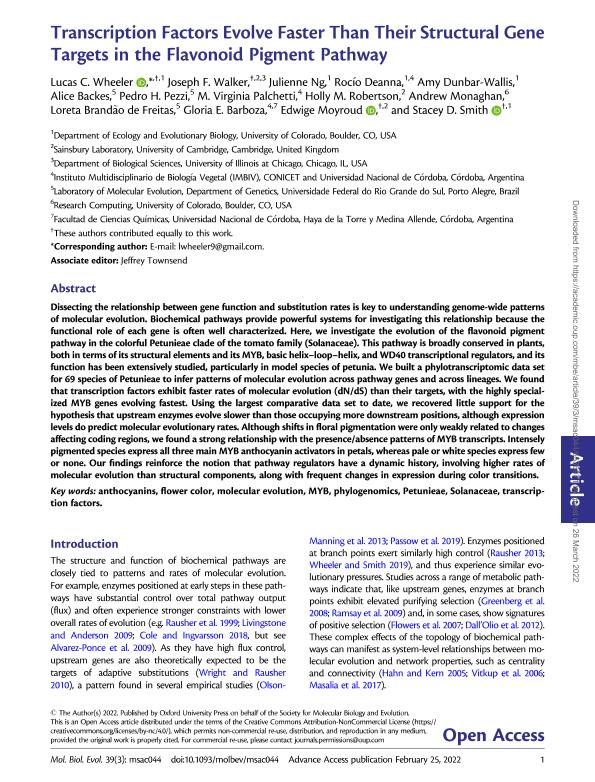Artículo
Transcription factors evolve faster than their structural gene targets in theflavonoid pigment pathway
Wheeler, Lucas C.; Walker, Joseph F.; Ng, Julienne; Deanna, Rocío ; Dunbar Wallis, Amy; Backes, Alice; Pezzi, Pedro H.; Palchetti, Maria Virginia
; Dunbar Wallis, Amy; Backes, Alice; Pezzi, Pedro H.; Palchetti, Maria Virginia ; Robertson, Holly M.; Monaghan, Andrew; de Freitas, Loreta Brandão; Barboza, Gloria E.; Moyroud, Edwige; Smith, Stacey Dewitt
; Robertson, Holly M.; Monaghan, Andrew; de Freitas, Loreta Brandão; Barboza, Gloria E.; Moyroud, Edwige; Smith, Stacey Dewitt
 ; Dunbar Wallis, Amy; Backes, Alice; Pezzi, Pedro H.; Palchetti, Maria Virginia
; Dunbar Wallis, Amy; Backes, Alice; Pezzi, Pedro H.; Palchetti, Maria Virginia ; Robertson, Holly M.; Monaghan, Andrew; de Freitas, Loreta Brandão; Barboza, Gloria E.; Moyroud, Edwige; Smith, Stacey Dewitt
; Robertson, Holly M.; Monaghan, Andrew; de Freitas, Loreta Brandão; Barboza, Gloria E.; Moyroud, Edwige; Smith, Stacey Dewitt
Fecha de publicación:
03/2022
Editorial:
Oxford University Press
Revista:
Molecular Biology and Evolution
ISSN:
0737-4038
e-ISSN:
1537-1719
Idioma:
Inglés
Tipo de recurso:
Artículo publicado
Clasificación temática:
Resumen
Dissecting the relationship between gene function and substitution rates is key to understanding genome-wide patterns of molecular evolution. Biochemical pathways provide powerful systems for investigating this relationship because the functional role of each gene is often well characterized. Here, we investigate the evolution of the flavonoid pigment pathway in the colorful Petunieae clade of the tomato family (Solanaceae). This pathway is broadly conserved in plants, both in terms of its structural elements and its MYB, basic helix-loop-helix, and WD40 transcriptional regulators, and its function has been extensively studied, particularly in model species of petunia. We built a phylotranscriptomic data set for 69 species of Petunieae to infer patterns of molecular evolution across pathway genes and across lineages. We found that transcription factors exhibit faster rates of molecular evolution (dN/dS) than their targets, with the highly specialized MYB genes evolving fastest. Using the largest comparative data set to date, we recovered little support for the hypothesis that upstream enzymes evolve slower than those occupying more downstream positions, although expression levels do predict molecular evolutionary rates. Although shifts in floral pigmentation were only weakly related to changes affecting coding regions, we found a strong relationship with the presence/absence patterns of MYB transcripts. Intensely pigmented species express all three main MYB anthocyanin activators in petals, whereas pale or white species express few or none. Our findings reinforce the notion that pathway regulators have a dynamic history, involving higher rates of molecular evolution than structural components, along with frequent changes in expression during color transitions.
Archivos asociados
Licencia
Identificadores
Colecciones
Articulos(IMBIV)
Articulos de INST.MULTIDISCIPL.DE BIOLOGIA VEGETAL (P)
Articulos de INST.MULTIDISCIPL.DE BIOLOGIA VEGETAL (P)
Citación
Wheeler, Lucas C.; Walker, Joseph F.; Ng, Julienne; Deanna, Rocío; Dunbar Wallis, Amy; et al.; Transcription factors evolve faster than their structural gene targets in theflavonoid pigment pathway; Oxford University Press; Molecular Biology and Evolution; 39; 3; 3-2022; 1-15
Compartir
Altmétricas



